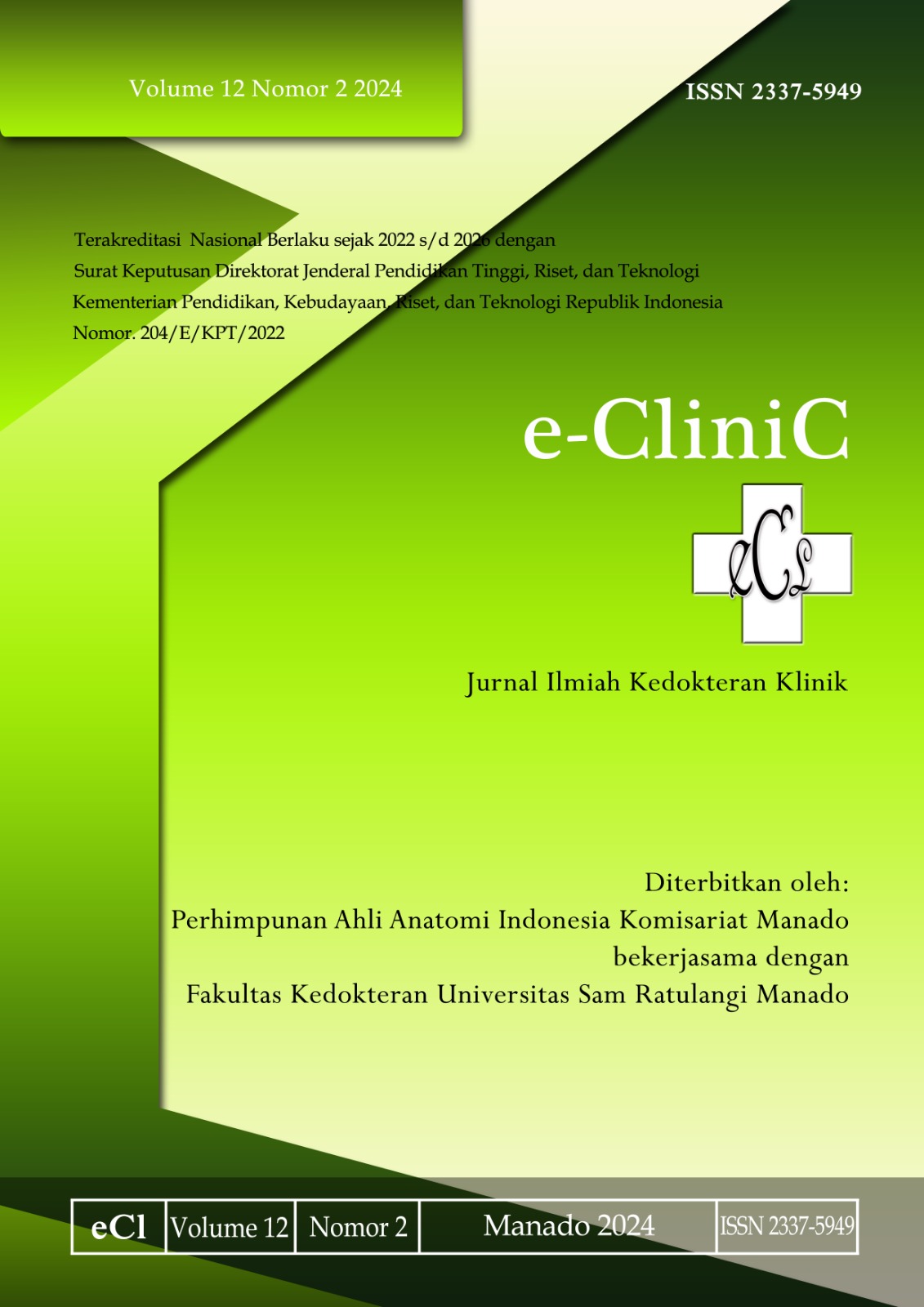Pattern of Skull and Facial Bone Fracture in Craniomaxillofacial Trauma Associated with Traumatic Brain Injury: A Retrospective Analysis at Tertiary Hospital
DOI:
https://doi.org/10.35790/ecl.v12i2.46477Abstract
Abstract: Trauma is one of the primary causes of death during the first four decade. Craniomaxillo-facial (CMF) trauma has become a common presentation in emergency departments of hospitals. The most presentation of CMF trauma includes skull and facial bone fracture and traumatic brain injury (TBI). This study aimed to obtain the pattern of skull and facial bone fracture in craniomaxillofacial trauma associated with traumatic brain injury. This was a retrospective study conducted on 501 patients from January 2020 to December 2021. Demographic data included age, sex, length of stay (LOS), and Glasgow coma scale (GCS). The results showed that from the total 501 patients with skull and facial bone fracture with or without traumatic brain injury, 406 (81%) were males and 95 (19%) were females. The age range of the patients was between 2 years and 86 years (mean±SD 33.9±18.2). The most common patient affected age ranged from 21 to 30 years. The average of LOS was 7.2±5.7 days (0-33) and the mean of GCS was 10.2±4.2. Based on types of cases, there were 232 cases (60%) of skull and facial bone fractures accompanied by TBI; 154 cases (40%) of only skull and facial bone fracture; and 339 (59.5%) cases of only TBI. In conclusion, the distribution of TBI increases in those with skull and facial bone fractures. On the other hand, the distribution of TBI is more common without fracture. Hence every skull and facial bone fracture must be carefully evaluated clinically and radiologically to rule out any underlying TBI.
Keywords: skull and facial bone fracture; craniomaxillofacial trauma; traumatic brain injury
References
Isik D, Gonullu H, Karadaş S, Koçak OF, Keskin S, Garca MF, et al. Presence of accompanying head injury in patients with maxillofacial trauma. Ulus travma acil cerrahi derg (Turkish Journal of Trauma & Emergency Surgery/TJTES). 2012;18(3):200-6. Doi:10.5505/tjtes.2012.01047.
Luce EA, Tubb TD, Moore AM. Review of 1,000 major facial fractures and associated injuries. Plast Reconstr Surg. 1979;63(1):26–30. Doi: 10.1097/00006534-197901000-00005.
Keel M, Trentz O. Pathophysiology of polytrauma. Injury. 2005;36(6):691–709. Doi: 10.1016/j.injury. 2004.12.037.
Tintinalli JE, Kelen MD, Stapczynski JS. Emergency Medicine: A Comprehensive Study Guide (6th ed). New York: McGraw-Hill; 2003. p. 1583–9.
Alvi A, Doherty T, Lewen G. Facial fractures and concomitant injuries in trauma patients. Laryngoscope. 2003;113(1):102–6. Doi: 10.1097/00005537-200301000-00019.
Follmar KE, Debruijn M, Baccarani A, Bruno AD, Mukundan S, Erdmann D, et al. Concomitant injuries in patients with panfacial fractures. J Trauma. 2007;63(4):831–5. Doi: 10.1097/TA.0b013e3181 492f41.
Hasnat A, Hoque AE, Azam MSU, Kamrujjaman M, Akhtar M. Pattern of maxillofacial trauma among patients with head injuries. Update Dent Coll J. 2017;7(1):14–20. Doi: https://doi.org/10.3329 /updcj.v7i1. 33304.
Elbaih AH. Resuscitation of polytrauma patients: an overview. Narayana Med J. 2016;5(2:126–40.
Latifi H. Prevalence of different kinds of maxillofacial fractures and their associated factors are surveyed in patients. Glob J Health Sci. 2014;6(7):66–73. Doi: 10.5539/gjhs.v6n7p66.
Elbaih AH, El-Sayed DA, Abou-Zeid AE, Elhadary GK. Patterns of brain injuries associated with maxillofacial fractures and its fate in emergency Egyptian polytrauma patients. Chin J Traumatol. 2018;21(5):287-92. Doi: 10.1016/j.cjtee.2017.12.005.
Grant AL, Ranger A, Young GB, Yazdani A. Distribution of major and minor brain injuries in facial fractures. J Craniofac Surg. 2012;23(5):1324–8. Doi: 10.1097/SCS.0b013e31825e60ae.
Joshi UM, Ramdurg S, Saikar S, Patil S, Shah K. Brain injuries and facial fractures: a prospective study of distribution of head injury associated with maxillofacial trauma. J Maxillofac Oral Surg. 2018;17(4):531-7. Doi: 10.1007/s12663-017-1078-8.
Haug RH, Savage JD, Likavec MJ, Conforti PJ. A review of 100 closed head injuries associated with facial fractures. J Oral Maxillofac Surg. 1992;50(3):218–22. Doi: 10.1016/0278-2391(92)90315-q.
Downloads
Published
How to Cite
Issue
Section
License
Copyright (c) 2023 Eko Prasetyo, Maximillian C. Oley, Ferdinan Tjungkagi, Yovanka N. Manuhutu, Antonius E. Sonbay

This work is licensed under a Creative Commons Attribution-NonCommercial 4.0 International License.
COPYRIGHT
Authors who publish with this journal agree to the following terms:
Authors hold their copyright and grant this journal the privilege of first publication, with the work simultaneously licensed under a Creative Commons Attribution License that permits others to impart the work with an acknowledgment of the work's origin and initial publication by this journal.
Authors can enter into separate or additional contractual arrangements for the non-exclusive distribution of the journal's published version of the work (for example, post it to an institutional repository or publish it in a book), with an acknowledgment of its underlying publication in this journal.
Authors are permitted and encouraged to post their work online (for example, in institutional repositories or on their website) as it can lead to productive exchanges, as well as earlier and greater citation of the published work (See The Effect of Open Access).







